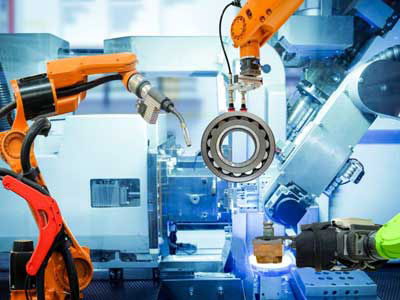Key Takeaway
Industrial robots are widely used in various sectors. In manufacturing industries, they handle tasks like fabrication, finishing, transfer, and assembly of parts. These robots ensure precision and efficiency. In material handling industries, robots are essential for picking, sorting, packaging, and palletizing products. They help streamline processes and reduce errors. Industrial robots are also found in automotive, electronics, and food and beverage industries. Their versatility and accuracy make them valuable for repetitive and complex tasks, improving productivity and safety across different applications.
Manufacturing Plants
Industrial robots are a cornerstone in modern manufacturing plants. They perform repetitive tasks with high precision and speed, such as welding, painting, and material handling. These robots improve productivity by operating 24/7 without fatigue. For example, in the automotive industry, robots assemble car parts with accuracy, ensuring consistency and quality. They also handle heavy and hazardous materials, reducing the risk of injury to human workers. By automating these tasks, manufacturing plants can achieve higher efficiency and lower production costs.

Assembly Lines
On assembly lines, industrial robots are indispensable for tasks requiring meticulous attention to detail and speed. They assemble electronic components, sort products, and package goods, ensuring uniformity across production batches. Robots like SCARA and articulated arms are commonly used for these tasks. In electronics manufacturing, for instance, robots place tiny components on circuit boards with precision that humans cannot match. This not only speeds up production but also significantly reduces errors, ensuring that the final products meet stringent quality standards.
In addition to assembling electronic components, these robots are adept at performing repetitive tasks that would be tedious and error-prone for human workers. They can work continuously without fatigue, increasing productivity and maintaining consistency in output. The integration of robotics in assembly lines also allows for real-time monitoring and adjustments, ensuring that any deviations from the set parameters are promptly corrected. This leads to higher efficiency and a reduction in waste, contributing to a more streamlined and cost-effective manufacturing process.
Warehouses and Distribution Centers
In warehouses and distribution centers, industrial robots streamline logistics and inventory management, significantly enhancing operational efficiency. Automated guided vehicles (AGVs) and robotic arms pick, pack, and sort items swiftly and accurately. These robots reduce the time needed to fulfill orders, thereby enhancing customer satisfaction. For instance, e-commerce giants like Amazon use robots to move shelves of products to human workers, who then pick items for shipping. This automation reduces human labor, minimizes errors, and increases the speed of operations, handling thousands of orders daily.
Moreover, robots in warehouses can operate around the clock, ensuring that the fulfillment process continues seamlessly even during peak times. They also improve inventory accuracy by continuously scanning and updating stock levels, preventing stockouts and overstock situations. This level of automation not only boosts productivity but also provides a safer working environment by reducing the physical strain on human workers. By optimizing space utilization and workflow, industrial robots help companies meet the growing demand for fast and reliable order fulfillment.
Research and Development Labs
Industrial robots play a crucial role in research and development (R&D) labs, assisting in experiments and handling hazardous materials with precision. Robots in R&D settings are used to test new products, conduct repetitive tests, and gather data with high accuracy. For example, in pharmaceutical labs, robots can handle delicate and dangerous substances, ensuring safety and precision in drug development. This allows researchers to focus on analysis and innovation, speeding up the R&D process and leading to faster breakthroughs and innovations.
Additionally, robots in R&D labs can perform complex tasks that require a high degree of precision, such as micro-manipulation or detailed measurements, which are critical in fields like biotechnology and materials science. Their ability to work in controlled environments without the risk of contamination further enhances the reliability of experimental results. By automating routine tasks, industrial robots free up researchers to concentrate on more creative and strategic aspects of their work, fostering a more productive and innovative research environment.
Hazardous Environments
In hazardous environments, industrial robots are essential for performing tasks that are too dangerous for humans. They operate in extreme conditions such as high temperatures, toxic atmospheres, and radioactive areas, performing tasks like inspection, maintenance, and disaster response. For instance, in nuclear power plants, robots inspect and repair equipment in radioactive zones, protecting human workers from exposure. Similarly, in mining operations, robots can explore and map out dangerous areas, ensuring worker safety and reducing the risk of accidents.
These robots are designed to withstand harsh conditions and continue operating effectively, even in the most challenging environments. They are equipped with advanced sensors and control systems that allow them to perform precise tasks remotely, minimizing human intervention. By taking on the most hazardous jobs, industrial robots not only enhance safety but also increase the efficiency and reliability of operations in these high-risk industries. This technological advancement ensures that critical tasks are completed without compromising human health and safety.
Conclusion
Industrial robots are used in a variety of settings, each leveraging their unique capabilities to enhance efficiency, precision, and safety. From manufacturing plants and assembly lines to warehouses, R&D labs, and hazardous environments, these robots are integral to modern industrial operations. Their ability to perform complex tasks without fatigue and with high accuracy makes them invaluable assets across industries. As technology continues to advance, the applications of industrial robots will only expand, driving further innovations and efficiencies in various fields.
